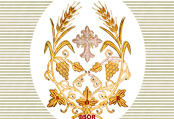
 |
|
||
| Patriarch Mor Ignatios Aphrem I Barsoum (1887-1957) |
|
Source: Photograph in the possession of the Archdiocese of Eastern USA and published in Patriarch Ignatius Aphram I Barsoum, The History of Syriac Literature and Sciences. tr. Matti Mousa. (Pueblo, CO: Passeggiata Press, 2000). Patriarch Mor Ignatios Aphrem I Barsoum was born on June 15, 1887, in Mosul, Iraq. He received his early education in a private Dominican school, studying French and Turkish as well as religious literature and history; later he learned Arabic under the training of Muslim scholars. At the Deir al-Za`faran monastery in Mardin, Turkey, where he started his theological training in 1905, he studied the Syriac language and literature. After his ordination as a priest in 1908, he remained at the monastery to teach, and in 1911 he assumed the additional responsibility of managing the monastery press. Later that year he began a scholar's visit to the monasteries and churches of Mesopotamia and Turkey. Soon after his return in 1913 he made a similar trip to examine Syriac manuscripts in the great libraries of Europe. On May 20, 1918, Patriarch Elias III consecrated Aphrem as metropolitan Mor Severius and named him the bishop of Syria. After World War I, he gained national recognition not only as a man of religion, but also as a man of learning. He championed the cause of Syrian unity, winning firm popular support by his admonition to the French to regard themselves as liberators rather than conquerors. In 1919, he was chosen to represent the national rights of the Syrian community in the peace settlement at Paris. He was disillusioned, however, by the atmosphere of self-interest which prevailed among the delegates representing the European powers, and at one stage of the conference found himself defending not only the rights of the Syrians, but those of the Arab nations. Though Mor Severius did not succeed in protecting the Syrian's interests at Paris, the journey gave him ample opportunity for further study of Syriac literature before his return in May, 1920. Two years later, the League of Nations' action making Syria a French mandate brought him the new responsibility of providing for refugees from Cilicia, and he also undertook the building of many new churches in and near Aleppo. Another journey took Mor Severius to Geneva and Lausanne as an apostolic delegate to the World Conference on Faith and Order (August 3-21, 1927). Soon afterwards he came as an emissary of the Patriarch to the United States, where he investigated the condition of the Syriac Orthodox Church, consecrated three new churches, and ordained new priests. He also gave lectures on the Syriac language and literature at the Providence University and the University of Chicago, and served at the Oriental Institute of the latter institution until his return in 1929. After the death of Patriarch Elias III in 1932, the Synod of Bishops named Mor Severius his acting successor. On January 30, 1933, he was formally elected Patriarch of Antioch, assuming the ecclesiastical name of Mor Ignatius Aphrem I Barsoum. The new Patriarch quickly showed himself as an active Church head, establishing new dioceses and founding a theological seminary at Zahla, Lebanon (later moved to Mosul, and then to Beirut). In the aftermath of the collapse of the Ottoman Empire and the political situation in the new state of Turkey, where Deir al-Za`faran, the seat of the Patriarchate, was located, Mor Aphrem was forced to relocate the Patriarchate to Homs in Syria. The great Patriarch passed away on June 23, 1957 and was buried in Homs. Despite the numerous responsibilities of his work in the Church and frequent interruptions for travel, the Patriarch devoted much of his time to writing. Chief among his published works are the following:
Patriarch Aphrem produced many other works which have never been published. His Syriac-Arabic lexicon and his compendium of church history in the 20th century are written in both Syriac and Arabic. His history of Tur `Abdin, in Syriac, was translated into Arabic by Bishop Bahnam. In Arabic, he also wrote a history of the Patriarchs of Antioch and the famous men of the Syriac Church, a history of Syriac Orthodox dioceses, an index of Syriac manuscripts, and translations of ten liturgies of the Syrian Church. Also, he translated into Arabic the second part of the Ecclesiastical History of Bar `Ebroyo in 1909 when he was a monk at the Monastery of Za`faran. Source: Patriarch Ignatius Aphram I Barsoum, The History of Syriac Literature and Sciences. tr. Matti Mousa. (Pueblo, CO: Passeggiata Press, 2000). |
| Copyright © Syriac Orthodox Resources. All Rights Reserved. |
| Last Update: December 19, 2001 |